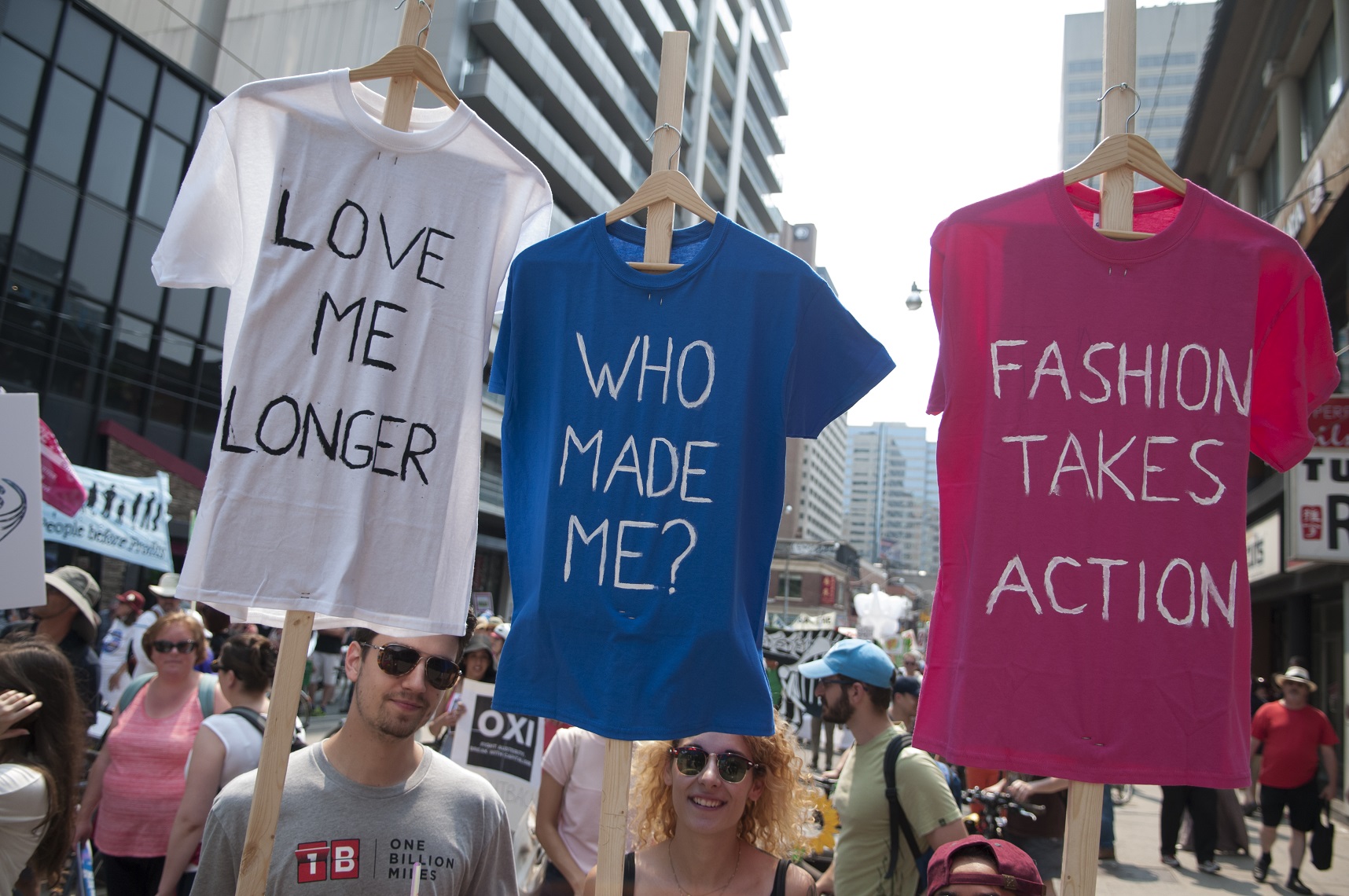How much does a T-shirt really cost?

79 or 39 PLN? Or even less on sale? And what if we look at it another way and convert it into the amount of water used to produce it and it comes out to be a substantial 2.7 thousand litres? And our wardrobe does not end with the T-shirt.
In less than 40 years, the amount of clothing bought by American women has increased fivefold. In 1980, the average US woman bought 12 pieces a year; in 2018, it was already 68 pieces. – according to information gathered by Rent a Runway. 80 per cent of the clothes purchased are rarely worn.
The situation is no different in Europe. Between 1966 and 2012, the number of clothes bought increased by 40 per cent. The average EU resident purchased 14.8 kg of clothing and footwear in 2020 (this includes home textiles). This compares to 12.66 kg in 2015. At the same time, almost half of the clothes in Europeans’ wardrobes had not been worn for a year.
Why do we buy so much? Because we want to keep up with fashion, which is changing faster and faster. There used to be four collections in the shops, each for a different season. Today, in the chain stores, new collections come out every few weeks. H&M releases between 12 and 16 a year, Zara even 24. The big chains rely on mass production, high sales volumes and low prices. They are quick to provide customers with items similar to those (albeit of inferior quality) that were shown on the catwalks not so long ago. When Zara and faux French opened their first shops in New York in late 1989, the New York Times newspaper wrote that the two brands spoke the same fashion language: ‘It’s a language understood by young people who want to be fashionable at small cost and who change their clothes as often as the colour of their lipstick’. The newspaper also quotes Juan Lopez, head of Zara in the United States: “The assortment in the shop changes every three weeks. We look for the latest trends. It takes 15 days from an idea [e.g. at a fashion show – editor’s note] to a product appearing in our shops”.
It’s supposed to be fast, it’s supposed to be accessible, it’s supposed to be cheap. And indeed – clothing is relatively getting cheaper, which is also conducive to buying. Between 1996 and 2018, clothing prices in the EU fell by more than 30 per cent in relation to inflation. And even if we buy more, we don’t feel it so much in our household budgets. In 1996, the share of these purchases was 5 per cent, dropping to 3.3 per cent in 2020.
Fast fashion is a child of globalisation. In recent years, it has been given a huge boost by social media. It is referred to as the “Duchess Kate effect”. The Duchess of Wales often shows up in clothes from chain stores, and the ones she wears (and whose photos circulate the internet) are bought up in droves. According to research commissioned by Accenture, one of the most important motives for buying clothes is becoming social media branding. As many as 55 per cent of respondents place importance on how they are dressed in photos and videos posted on these platforms. One in four people under 25 buy clothes with a view to how they will appear in them on social media. Older respondents are not much different, with 19 per cent of the total respondents indicating the same answer (The Second Life of Clothes, 2022 – in Polish).
How much does a seamstress earn?
The problem is that clothing production is not as beautiful as the pictures on Instagram. On 24 April 2013, an eight-storey building in the Rana Plaza complex in the Bangladeshi capital, Dhaka, collapsed. It housed, among other things, sewing factories producing for a number of well-known brands. The building was being expanded to accommodate as many machines as possible, and the power generators running for many hours made it vibrate. Eventually, the structure failed to hold. The disaster killed 1,118 people and injured around 2,500. The tragedy was an eye-opener for many consumers, as it clearly demonstrated what human rights organisations had been saying for a long time: that seamstresses work in conditions that disregard occupational health and safety, for several hours a day, earning starvation wages. That they cannot complain or associate (e.g. in trade unions), that child labour is often employed in the factories and that they work seven days a week, with no holidays or right to sick leave.
Ten years after the Rana Plaza disaster, the situation of clothing industry workers in Bangladesh (it accounts for 82 per cent of the country’s exports) has improved significantly, as the International Labour Organisation acknowledges, but much remains to be done. Pressed by public opinion, the fashion companies for whom the factories in Rana Plaza sewed signed the Accord agreement in 2013. It dealt with the safety of the sewing factory workers and the payment of compensation to the victims (which the business was in no hurry to do). If the factories want to cooperate with the Accord signatories, they must undergo an audit.
It is not only Bangladesh that sews for the world. There are also numerous factories producing clothing or footwear in China, India, Pakistan or Cambodia. They are referred to as sweatshops (to sweat means also to work hard). Their common denominator is harsh and sometimes even dangerous working conditions, working several hours a day, minimum wages for which it is impossible to make a living and the employment of children. In Bangladesh, the hourly wage is 22 cents, in India it is 58 cents.
Working in the clothing industry is also hazardous to health. Jeans achieve abrasion through sandblasting. This involves spraying sand onto the fabric using a high-pressure gun. Silica particles float everywhere, penetrating into the lungs and causing a deadly disease – silicosis of the lungs. In theory, every worker should wear protective clothing and a mask. In practice, the only protection is a face scarf. In 2009, the Turkish authorities banned this method in the textile industry, after 40 people died of silicosis in the country between 2004 and 2009. However, the production of sandblasted jeans has moved to other countries. Some brands (e.g. H&M, Levi’s) are themselves phasing out the use of this method for sewing jeans.
Workers producing clothes are also exposed to direct contact with chemicals – dyes, bleaches, adhesives, solvents, surfactants, flame retardants or formaldehyde. 90 per cent of Bangladeshi slum dwellers who work in leather production die before the age of 50.
How much water will be used?
Chemicals poison not only the people who work with them, but also the soil, water and air. These, by the way, are not the fashion industry’s only sins against the environment. It is responsible for as much as 10 per cent of the world’s greenhouse gas emissions. This is more than international flights and shipping.
In 2015, the clothing industry used as much as 79 billion cubic metres of water. As much as 2,700 litres of water required to produce one T-shirt is roughly the amount a person drinks in 2.5 years. A pair of jeans consumes around 8,000 litres. Why so much? Incredibly water-intensive is the cultivation of cotton itself. It takes as much as 20,000 litres of water to produce a kilogram of it. On top of this, there are huge amounts of fertilisers and pesticides. Although the plant occupies 2.4 per cent of the world’s arable land, its production involves the use of 5.7 per cent of the total pesticides used in agriculture. Raw cotton still has to undergo a series of treatments before it becomes material for a T-shirt or jeans. Up to 8,000 different chemicals are used for these, including chlorine-based bleach, dyes containing heavy metals or formaldehyde to prevent the material from creasing.
Cotton accounts for 24 per cent of the global fibre market, polyester for as much as 52 per cent. It is produced from petroleum. It is an energy-intensive process, causing microfibres to contaminate the water. They are released not only during production, but also during washing, especially the first cycles (and this is not a material designed for long wear). Every year, half a million tonnes of microfibres end up in the seas and oceans. This is 35 per cent of the primary microplastics released into the environment.
The clothing industry is growing all the time. Back in 2000, global fibre production was 58 million tonnes, rising to 111 million in 2019 (according to Textile Exchange). This has an increasing environmental impact. In 2015, the entire industry consumed 98 million tonnes of oil and was responsible for 2 per cent of global CO₂ emissions. By 2050, oil consumption is expected to increase to 300 million tonnes and emissions to 26 per cent. At the same time, 22 million tonnes of additional microplastic particles will enter the seas and oceans.
How long will a T-shirt last?
Every year, an EU citizen disposes of around 11 kg of clothes. In various ways – by giving to others or selling, throwing away or recycling. Between 25 and 50 per cent of discarded clothing is already so worn out that it ends up in a landfill or incinerator. Quite a lot ends up in second circulation and is shipped to other countries in Asia and Africa. These exports are growing, in 2003 it was 400,000 tonnes, in 2019 already 1.3 million tonnes. The flood of cheap clothes from Europe is causing local manufacturers to lose their jobs. In Uganda, about 81 per cent of the clothes sold are second-hand from the West. Clothes that don’t sell end up in huge landfills, which is what happens in Ghana and Chile, for example. The British charity Oxfam estimates that this applies to as much as 70 per cent of exported second-hand clothing.
Less than 1 per cent of clothing is recycled as clothing. Mechanical recycling still dominates – clothes are used as rags, insulation or filling for upholstered parts of cars. About 20 per cent of textile waste in the EU ends up this way.
Fast fashion does not live long. These are not clothes sewn to last for years. Their durability also depends on the users – how and how often they wash them and whether they repair them. 42 per cent of Poles surveyed declare that they mend their clothes – mainly for economic and sentimental reasons. Some brands also encourage this – for example, Patagonia, known for its responsible approach to environmental issues (and definitely not fast fashion), has videos on its website showing how to, for example, sew up a hole in a jumper or replace a button in jeans.
How much more?
Patagonia was also the first major company to launch an official online shop with its second-hand products. Today, more brands (e.g. Levi’s, COS, 4F) as well as shops (e.g. Zalando) offer this, although it is still a niche. However, this does not change the fact that the second-hand clothing market is growing very fast, mainly on the internet – from online second-hand shops to platforms such as Vinted, which recorded 80 million users last year.
A report commissioned by Thred UP, a US online second hand store, shows that second-hand items are expected to account for 10 per cent of the total clothing market in 2023. The value of the global second-hand market is growing year on year – in 2022 it was USD 177 billion, it is forecast to reach USD 351 billion in 2027.\
The second textile cycle is a step towards a circular model, in which the entire life cycle of a product is already envisaged at the planning stage and designed so that its production uses as little raw materials and energy as possible and that it serves as long as possible, with as little waste left behind at the end. The fast fashion model to date is very linear: lots of raw materials, lots of energy, short life and then it goes into the rubbish. Closed-loop fashion involves producing products with materials and methods that have less impact on the environment, are sustainable and last for years. It includes taking care of the product, repairing it, reworking it, giving it away to others and recycling it when it is completely worn out. And above all, moderation.
Other business models, such as rentals (e.g. clothes for special occasions or children) and subscriptions (for a certain amount of money, you get a few clothes each month, which you can return or buy back at a lower price), are also part of the closed loop.
EU regulations are also moving towards a circular model. On 1 June 2023, the European Parliament voted through legislation to curb overproduction of textiles and fast fashion. The idea is to make clothes more durable, repairable or recyclable – for example, so that it is easy to unpick the zip to replace it or to separate different fractions of waste. The EP would like shops to offer the possibility to repair or maintain clothes, as well as to improve the production conditions of clothes and shoes that reach the EU market. Pseudo-environmental advertising and the incineration of unsold or returned products will be banned.
From 2025, EU countries will also have to collect textiles separately – the Waste Directive forces them to do so.
EU politicians have assumed that without top-down regulation, the fashion industry will not change. This is especially true given that forecasts predict further growth (63 per cent between 2022 and 2030). Because fast fashion makes a profit. But a T-shirt costs much more than the price stated on the label.
What happens to goods purchased online that we return? What is return logistics? Read on our blog.




